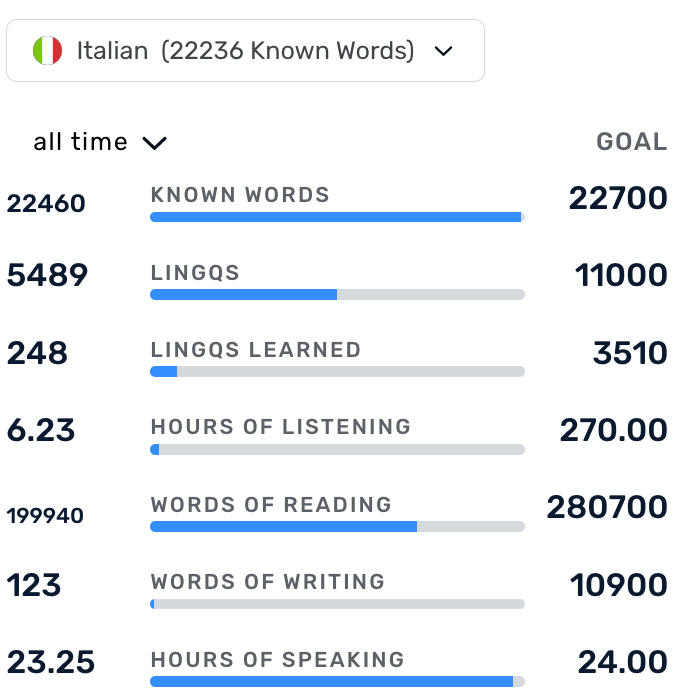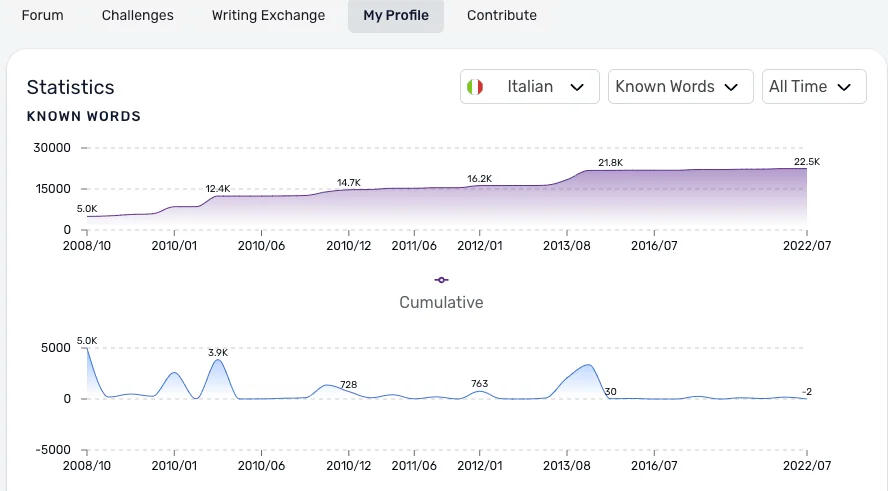TL;DR Summary
The best way to learn Italian is to live in the language. Read and listen every day to things you enjoy, and don’t worry too much about grammar — check it only when you’re curious. Tools like LingQ make it easy to notice and review words without breaking your flow. If you already know Spanish or French, even better. Just keep exposing yourself to Italian and trust that it’ll start to make sense naturally.
Italian has always fascinated me—not just as a language, but as a gateway to Italy’s rich culture, history, and people. Years ago, I traveled and hitchhiked through the country without speaking a word of Italian, relying instead on my Spanish to communicate. Even then, the warmth of the people, the beauty of the places, and, of course, the food convinced me that I needed to learn Italian.
In this post, I’ll share the resources and strategies that worked for me, how my approach has evolved over time, and what I believe is the best way to learn Italian today.
How I Started Learning Italian
I started learning the Italian language with the Linguaphone series. This is an at-home course to learn Italian independently. I found the courses overpriced, as I only really needed the text, audio and a glossary. Furthermore, I’ve always found the comprehension exercises unnecessary.
Comprehension questions spoil the pleasure of reading, and they’re not ideal for a language learner with limited time. Besides, when reading and listening to a language, the goal is not perfect comprehension. A language learner’s main priorities should be consistency and enjoyment. So, I skipped all of the practice exercises, but embraced repetition. It’s helpful to listen and read things several times to absorb the vocabulary.
I’ve never been a fan of bilingual books with Italian on one side and English on the other. For me, it’s not an effective way to learn—I don’t want to keep scanning the English text just to match it to the Italian.
When I read or listen to Italian, I aim for a natural sense of flow, and that means avoiding interruptions. Years ago, this was much harder. I’d have to flip to the glossary in Armida Roncari’s Prime Letture Italiane Per Stranieri every time I hit an unfamiliar word, breaking my rhythm. Today, tools like online dictionaries and LingQ have largely made that kind of stop-and-start reading a thing of the past.
“Freebie Italian“
Obviously, if you speak French or Spanish, you have an advantage when learning Italian. The lexical similarity (the amount of words in common) is quite significant. Therefore, you can understand a lot of Italian material from the very beginning and progress to more authentic materials more quickly.
People often make a big fuss about “false friends,” words that appear to have the same meaning across both languages, but actually do not. Sure, subire in Italian and subir in Spanish have different meanings. But this does not diminish the benefit of studying closely related languages with lots of common vocabulary.
How I Approached Italian Grammar
I used a great Italian grammar book called Essential Italian Grammar by Olga Ragusa, which I refer to often. This is a great resource because the different Italian pronouns can be quite difficult. I found it beneficial to review the rules and then watch for them when reading and listening to my Italian content. This was never a resource to memorize or drill, but rather seek quick explanations and additional examples.
Learn Italian with Audiobooks

One of the biggest boosts to my Italian came when I discovered Il Narratore, a tiny audiobook publisher tucked away on a hillside near Verona. They produce wonderful Italian audiobooks, including an outstanding version of I Promessi Sposi, a classic of Italian literature. Many Italians remember it from school and find it dull, but for me it was the opposite—set in another century and another country, it felt rich, vivid, and exotic. It was the kind of story that drew me in completely, and I still remember jogging through Palm Springs while listening to it.
That’s the power of interesting content—it pulls you along and makes the language easier to absorb. Il Narratore also offers a superb audiobook of Pinocchio, and with classics like these, you can easily find the digital text online, import it into LingQ, and link the written and spoken word. It’s a far more engaging and effective way to learn than slogging through bilingual textbooks or flipping through glossaries.
The Best Way to Learn Italian: LingQ
If I could learn Italian all over again, I’d do it with LingQ. LingQ is a reading platform designed for language learners. LingQ removes barriers between you and finding that sense of flow while you read and listen to your target language.
For example, I want to read Umberto Eco novels, but there are too many words that I don’t understand. If I read a paper copy, I’ll end up underlining too many words (never looking them up), and struggling to enjoy the content. With LingQ, however, I’m able to instantly translate and save new vocabulary for later review, enhancing my comprehension in the process.
I’ll show you how I’ve studied Italian recently on LingQ. If I click on my profile and look at my activity, you can see that I have 22,236 known words, and that I was particularly active back in 2008. I’ve revisited the language a bit more sporadically since then.
If I look at my LingQs created, I can see that there are only 5,000 of them. This tells me that the bulk of my known words came from words that I saw in the text, but didn’t have to look up. Why is this useful information? Well, LingQ determines your vocabulary level as you read, allowing you to more accurately gauge the difficulty of texts, your rate of progress, etc.
If I look at the amount words I’ve read, I can see that I’ve read a fair number. I’ve also read a lot of blogs, articles, transcripts, etc., and I’m able to better visualize my learning habits using LingQ.
How Long it Takes to Learn Italian
Well, how long does it take to learn a language in general? This ultimately depends on you, your motivation, and your previous experience with language learning. For an English speaker, Italian is not difficult to learn. It’s of comparable difficulty to learning Spanish or French.
The Foreign Service Institute (FSI) classifies Italian as a Category I language, the lowest difficulty. The FSI also suggests that an English speaker would need 600 hours of classroom instruction to achieve a B2 in Italian on the CEFR scale, a common benchmark for fluency. We can take learning into our own hands and study outside of the classroom environment, but let’s use this number as a reference.
If you commit an hour per day to learning Italian, you’ll need between 1.5 and 2 years to reach fluency. However, if you were to study more intensively, allotting 3 hours per day to Italian, you’d reach the same level within 6-7 months. In short, your rate of progress depends on you and how intensively you’re willing to learn.
My Future with Italian
Currently, I can communicate in Italian, but not as well as I’d like. I understand most of what I hear, yet when I open a book, there are still words I don’t know. If I weren’t focused on Arabic and Persian right now, I’d likely be able to bring my Italian up to the next level—within about three months.
I’ve brought my Italian to the point where it’s no longer “semi-Spanish” but truly Italian. With LingQ, I know I could sharpen it quickly before a trip to Italy or an interview in the language, taking my rusty B2 to a solid B2 or even C1. Italian is a beautiful, rewarding language, and the journey of learning it has been pure enjoyment. If you’re learning it too, immerse yourself, follow your interests, and most of all—enjoy the process.
FAQs
1. What’s the best way to start learning Italian?
My recommendation to start learning Italian is to read and listen to the language daily. Build strong habits with level-appropriate content. LingQ’s Italian mini stories are a great place to start.
2. Should I use bilingual books?
I avoid them. They break the flow of reading.
3. Is Italian easier if I already speak Spanish or French?
Absolutely. You’ll already understand a significant portion of written and spoken Italian. You’ll recognize a lot of vocabulary from the start, which means you can push yourself towards authentic content sooner.
4. How should I approach Italian grammar?
Use grammar as a quick reference, not something to memorize. Learn the rules, then notice them in the content you’re reading and listening to.
5. What’s your top resource for learning Italian today?
LingQ—because it lets me read and listen to content I care about while instantly looking up and saving new vocabulary, keeping me in that all-important state of flow.
6. How many hours does it take to learn Italian?
The Foreign Service Institute suggests that a professional competency in Italian requires between 600-750 hours of study. However, I believe a lot of language learning progress occurs outside of the classroom. I go into the phases of language learning in more detail here.





